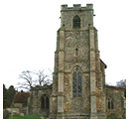  |
 |
 |
 |
 |
| Fri 31 Oct 2025 |

The History Of All Saints' WickhambrookWall Paintings - January 2005The restoration has just become all the more exciting with the recent discover of mediaeval wall paintings in the form of scrollwork. This scrollwork was discovered in the nave saddled between two of the main arches on the north wall and below the height of the clerestory windows. The scrollwork had been obscured behind limewash used to paint the interior of the church. The limewash had been displaced with the removal of some of the old electrical system revealing the mediaeval wall painting beneath. Due to this exciting discover work was halted and an expert was called in from London. She visited us on Saturday 29th January and is currently writing a report on the findings. A transcript of her report will be made available soon. However for the moment the scrollwork can be described as a decorative pattern in reds and browns. This discover has put the restoration work back about one week however the expert opinion following the visit was that the restoration work could recommence with the area exposed to be restored at a future date. It should be realized that historically churches were highly decorated inside. To get a feel for what they must have looked like one would have to compare them to many of the grander continental churches today. However even though our churches were painted very little appears to remain. This is for three main reasons. Firstly wall paintings were originally not conceived to be permanent. The work of the artist would have faded over time and be replaced or reformed at intervals over the years as the building expanded or was redesigned inside. Forms of artwork would have become unfashionable and fire and water damage will have lost some work to us. Secondly a major consideration was the Reformation, this was a period in our history when all carvings, statues paintings were destroyed or removed from our churches. Mainly in the case of wall paintings this meant that they were obliterated solely by being limewashed over. Interestingly although this has removed wall paintings from out gaze it has protected the underlying artwork over the centuries. Thus as is the case here at All Saints' when restoration work occurs wall paintings are rediscovered and found to be in very good condition without the paintwork fading at all. Thus this type of loss of visible wall painting can be reversed. However the third reason for the loss of wall paintings was due to an altogether non-reversible event - namely the removal of plasterwork from churches to reveal the underlying stonework. This kind of restoration was a Victorian idea; thus with the removal of the plasterwork so the wall paintings were lost for future generations. Indeed we in East Anglia are very lucky since the underlying rubble masonry stonework of our churches is poor by comparison to that of the north were they built churches from good stone which was worth exposing. Thus they have their stonework exposed and have lost their wall paintings whilst ours survive intact if often hidden from view. Apart from the obvious decorative statement that scrollwork made in a church the major reason for painting on the walls was to depict graphically scenes and stories from the bible. These stories could then be easily conveyed to a parish whose congregation may have been wholly illiterate. An excellent example would be the Doom painted above the chancel arch depicting the Last Judgement. A very good example of a doom is actually present in our benefice at Cowlinge church. Due to the very high standing All Saints' Wickhambrook had as an important church in the past it is conceivable that there will be a number of other wall paintings present in the church waiting to be discovered. Who knows maybe we have a Doom also. Only time, willing and resources will tell. |



